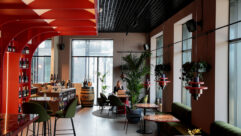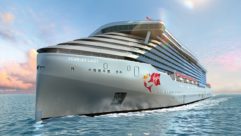A Glimpse of the Sea
Nov 1, 2002 12:00 PM,
By Kelly McCarthy
In 1968, the year the summer Olympic games were held in Mexico City and Apollo 8 began its first mission to orbit the moon, the North Carolina Marine Science Council approved three Marine Resource Centers along the coast of the Atlantic Ocean. Eight years later, Governor James Holshouser Jr. officially opened the North Carolina Resource Centers on Roanoke Island, Bogue Banks, and Fort Fisher. Originally designed as multipurpose research, education, and marine advisory facilities, the resource centers provided educators with lab space, aquatic habitats, and other tools to teach marine science.
Shortly after opening, directors of the three centers realized that the public was eager for information about the state’s diverse aquatic environments. Within a few years, the centers changed their focus to meet the demands of tourist and public-school groups searching for interactive exhibits and educational programs. In 1986 the centers were renamed the North Carolina Aquariums at Roanoke Island, Fort Fisher, and Pine Knoll Shoals.
To keep up with the public interest, the Fort Fisher Aquarium expanded its tank from 17,000 to almost 300,000 gallons and is now home to 250 species. Volunteer staff increased from 30 to 100 to accommodate the additional 150,000 guests who visit the aquarium each year. The median time spent at the aquarium by visitors also lengthened from 1.5 hours to 2.5 hours. The aquarium growth can be attributed to the newly expanded half-acre freshwater Cape Fear Conservatory as well as the two-story saltwater habitat called Cape Fear Shoals.
Directors from the North Carolina Aquarium Society and the North Carolina Aquariums began to visualize the master renovation and expansion plans in 1989. Input from aquarium management, employees, and visitor surveys were incorporated in the discussions of how the aquarium would evolve in years to come. As a result, the organization agreed upon a dramatic increase in tank size, additional exhibits, facility expansion, and interactive experiences designed for educational and entertainment purposes. Construction on Fort Fisher began in the spring of 1999.
VOICES FROM THE DEEP
As the Fort Fisher Aquarium facility expansion plan developed into blueprints, an interactive dive audio system was added to enhance the 235,000-gallon Cape Fear Shoals exhibit. Because Fort Fisher did not have an existing system to work from, the Aquarium Society had to start from scratch when designing the exhibit enhancement. Having little or no experience with audio design and technology, the society enlisted Risky Waters Underwater Consulting Services of Wilmington, North Carolina, to design the project. In turn, Risky Waters selected Southeastern Sight and Sound (SESS) of Raleigh, North Carolina, for additional audio consulting and design.
The special technical needs of the project had to be balanced with the timetable and budget and give the customer the level of dependability needed for commercial diving endeavors. Bill Lotz, president of Risky Waters, presented a plan for making the concepts a reality. “It was important to incorporate flexibility with function,” Lotz said. A commercial diver himself, Lotz combined his expertise in underwater audio with diving techniques to create a technologically advanced system to match the needs of the aquarium. Those needs included building an interactive dive communication system that would allow visitors and divers to clearly and easily communicate with each other. Divers had to have the ability to swim throughout the tank while still conversing with the audience. Because the audience changes, the system needed to have the ability to provide clarity and intelligibility between the different wireless microphone users and divers.
Divers were trained in special breathing techniques so their communication to the audience would be clear and easily understood. Bill Parker, dive safety officer coordinator for the Fort Fisher Aquarium, trained each diver how to maximize breathing efforts to best communicate with the various types of visitors.
DIVER DOWN
With input from aquarium divers, educators, directors, and audio experts, the communication system was designed using the latest technologies. The individuals involved on the underwater side of this project had already selected equipment they were familiar with and had a high confidence level in the divers. SESS had to use the most dependable equipment manufacturers and integrate available off-the-shelf components in a nonstandard configuration.
Hal Drane, president of SESS, said he chose Clear-Com and Ocean Technology Systems (OTS) products for their advanced technologies in underwater communication systems. Ocean Technology Systems manufactures a commercial line of diving masks with mics and speakers for communication between divers. The components already available inside the OTS equipment deal with many of the special needs of underwater microphones and speakers.
The four-wire Interface and Intercom Power Supply made by Clear-Com offers features such as automatic short-circuit protection, carbon or dynamic mic emulation, and individual transmit, receive, and null controls.
The equipment had to overcome changing air-pressure levels, acoustics occurring in a mask with the airflow of the oxygen tanks, ambient underwater noise levels, divers breathing in the proximity of the mic, saltwater corrosion, and waterproofing.
The importance of using standardized, dependable, specifically adapted equipment for the divers cannot be overstated. One challenge was to interface with the OTS wiring, impedance, and power requirements. The engineering expertise of Clear-Com, OTS, SESS, and Risky Waters were combined as a solution. OTS fabricated adapters to connect its special cabling to the divers’ masks and then to Clear-Com’s interface panels mounted externally by the tanks. Clear-Com provided engineering support by supplying a component level modification and continuing to support the equipment warranty after the modification.
The modifications to the Clear-Com interfaces resolved the impedance matching and power requirement concerns. The Clear-Com equipment also provided for balancing of audio levels in both directions, communication with a diving-safety supervisor from above the tank, and a place to interface with other audio sources. SESS performed the modifications, integrated the equipment on-site, performed system setup and alignment, and tested and trained the aquarium’s personnel in operation of the system. Risky Waters oversaw the process to ensure that the ergonomics and environmental issues were not ignored.
CAN YOU READ ME?
An integral part of the aquarium’s communication system is the remote speaker station. The Clear-Com KB-211 allows the user to talk and listen between two channels. The station also lets the surface personnel listen using a headset or push-to-talk microphone. In this installation, the Clear-Com PT-4, a push-to-talk handset, was used with the intercom speaker station. The PT-4 was selected for its durability in rugged, heavy-duty environments. Two TOA Electronics A-512 amplifiers were selected for their versatility and high-power performance. The A-500 series offers 30W, 60W, or 120W RMS output power and remote mic volume control.
Loudspeakers were installed in the viewing gallery and the moray room. Ten Soundtube RS55i-SM speakers were selected for the viewing gallery area and two KSI Professional speakers for the moray room. Soundtube’s cast composite enclosure, Broadbeam dispersion speakers are strategically surfacemounted in the viewing gallery to reach both floors evenly. “The RS55i-SM provides superior clarity and intelligibility in an environment with higher-than-average ambient-noise levels,” Drane says.
Because they typically have gaggles of excited children watching the divers show each saltwater creature, the rooms have higher-than-normal ambient-noise levels. The KSI speakers provide an in-ceiling solution for the moray room. The system was designed for two-way communication between the diver and the audience and sound system, which utilizes an RCA five-disc CD changer for background music and messaging between exhibits. A Shure LX wireless microphone system was selected for its reliability and compatibility in live environments, as well as for its ease of use.
The next concern was to install equipment that would not detract from the overall experience of the public visiting the museum and would be easily operated by museum educators. A series of speakers from the Soundtube line were chosen to support the main aquarium-viewing gallery. This area is multitiered and open to other exhibits in close proximity. The speakers had to be mounted where they would give excellent coverage and intelligibility while being nearly invisible to the eye. They also had to be directed in such a way as to minimize interfering with visitors touring other exhibits. The components making up the head end of the system were rackmounted in a wallmounted Middle Atlantic rack with a swiveling rear-access pan and a locking front door to restrict unauthorized access. A second room used some of KSI’s line of 2-by-2 ceiling-style replacement lay-in speakers to blend with the ceiling in a second room at the rear of the aquarium, which can support a second portion of the tank for a separate showing area.
The Clear-Com interface in the rack can support additional equipment and a second channel for future expansion. That was provided to accommodate dual shows in the future. The rack also houses a receiver for a Shure wireless microphone and a Behringer feedback processor so the visitors can talk freely to the divers. The two TOA mixer amplifiers drive the speakers. Each area has a mixer amp to provide independent volume control and the ability to use different sources simultaneously.
THE BRINY DEEP UNVEILED
After two years of renovation and expansion, the North Carolina Aquarium at Fort Fisher reopened its doors on March 22. The completion of the new interactive dive system has been an overwhelming success for aquarium staff and visitors. In retrospect, there are few changes the aquarium staff would recommend for the audio system. “We are very pleased with the system,” says Angie Holder, A/V manager of the Fort Fisher Aquarium. “After making a few adjustments with the sound levels and training of the divers, the system has added excitement to the overall visitor experience through audio innovations.” Expansion plans for the North Carolina Aquarium at Pine Knoll Shoals are underway, and construction is set to start later next year.
Kelly McCarthy is responsible for marketing and media relations at Soundtube Entertainment. She can be reached at [email protected].
For More Information
Behringer
www.behringer.com
℘ 240
Clear-Com
www.clear-com.com
℘ 241
KSI Professional
www.ksipro.com
℘ 242
Middle Atlantic
www.middleatlantic.com
℘ 243
Ocean Technology Systems
www.oceantechnologysystems.com
℘ 244
RCA
www.rca.com
℘ 245
Shure
www.shure.com
℘ 246
Soundtube
www.soundtube.com
℘ 247
TOA Electronics
www.toaelectronics.com
℘ 248
Ž Circle this number on Reader Service Card or visit freeproductinfo.net/svc








